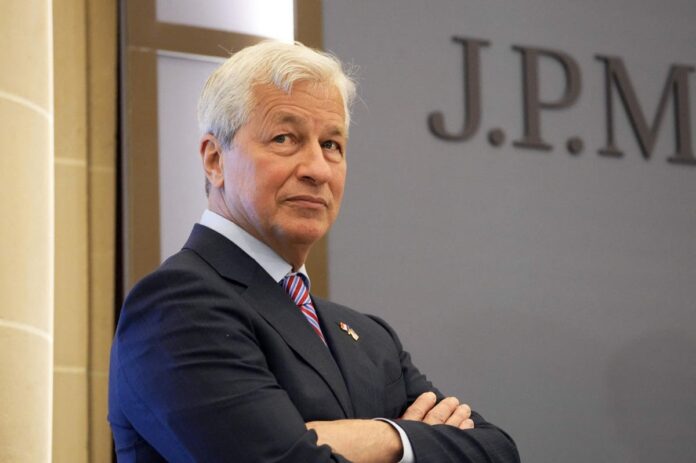“I am not sure if the world is prepared for 7%,” says JPMorgan Chase CEO Jamie Dimon.
MICHEL EULER/POOL/AFP via Getty Images
In a recent interview with the Times of India, JPMorgan Chase CEO Jamie Dimon warned that markets fearing higher U.S. yields haven’t seen anything yet.
It’s concerning that one of Wall Street’s most recognizable names thinks the Federal Reserve could hike rates far more than most thought possible. Just a couple of months ago, the overwhelming conventional wisdom was that today’s 5.25%-5.5% range for Fed rates would be the top tick.
“I am not sure if the world is prepared for 7%,” Dimon said. “I ask people in business, ‘Are you prepared for something like 7%?’ The worst case is 7% with stagflation. If they are going to have lower volumes and higher rates, there will be stress in the system. We urge our clients to be prepared for that kind of stress.”
Asia is not ready for such a scenario. The mini panic in stock markets from Japan to South Korea to Australia this week suggests markets wouldn’t like the picture Dimon is painting. Not one bit.
Nor are government officials here likely to be happy about Dimon riffing on Warren Buffett’s famous observation that “only when the tide goes out do you discover who’s been swimming naked.” In Dimon’s telling, more aggressive than expected Fed tightening moves “will be the tide going out.”
The problem, of course, is that there’s been a lot of economic skinny dipping going on in Asia. That’s particularly so since the 2008 Lehman Brothers crisis, a shock that arguably set in motion—or accelerated—massive pre-Covid-19 debt buildups around Asia.
In the process of building residential projects like this one in Huaian, in China’s Jiangsu province, China Evergrande Group’s debts soared to more than $300 billion.
Zhao Qirui/VCG via Getty Images
In Japan’s case, the fallout from that period saw Tokyo stepping up already gargantuan borrowing efforts to safeguard growth. It also drove the Bank of Japan to revive quantitative easing to help keep bond yields from skyrocketing.
Fallout from the Lehman era saw an explosion of Chinese debt issuance. From 2009 on, Beijing and prefectural governments went on modern economic history’s greatest borrowing years. Cities throughout what’s now Asia’s biggest economy raced to build skyscrapers, apartment complexes, six-lane highways, international airports and hotels, white-elephant stadiums, sprawling shopping districts and amusement parks.
The price for all that unproductive building became obvious in 2021 when China Evergrande Group hit a wall.
For China, the pandemic was a tide-going-out event. Yet surging U.S. Treasury debt yields that slam Chinese exports and its bond and stock makers could cause ever more disruptive waves.
Korea, meanwhile, emerged from the Covid-19 crisis first in Asia. In mid-2021, when China Evergrande was defaulting, the Bank of Korea became the first major monetary authority to hike rates post-pandemic.
Yet as the Fed removed more liquidity, investors are being reminded Asia’s fourth-biggest economy has a household debt debacle on its hands. At the end of June, the balance of household credit stood at $1.4 trillion, up more than $7 billion in just the previous three months.
It’s become quite the headache for central bank Governor Rhee Chang-yong. “A soft landing for household debt” is now the BOK’s top priority, Rhee said in late August.
As Rhee explained, “it’s time to adjust property policies, which were eased to prevent the sector’s hard landing late last year. We will consider macro policies if the adjustment through micro policies is not enough.”
Nor are the export-dependent economies of Southeast Asia ready from the Fed Chairman Jerome Powell’s team to “be the tide going out,” as Dimon would say.
The region remembers all too well what happened the last time the Fed hit the brakes with comparable force. That was back in 1994 and 1995, when the Alan Greenspan Fed doubled short-term borrowing costs in just 12 months.
The dollar’s resulting years-long rally made currency pegs in Bangkok, Jakarta and Seoul impossible to defend. Devaluations beginning with Thailand in July 1997 set off a domino effect. After Indonesia and Korea devalued, speculators began training their sights on Malaysia, the Philippines and beyond.
No doubt developing Asia has come a long way since then. Banking systems are sounder and less tethered to politics. Corporate sectors are better managed and more transparent. Economic growth engines are more diverse. Governments built up ample foreign-exchange reserves.
Yet debt overhangs—imbalances made worse by the pandemic—abound, leaving developing Asia highly exposed to rising U.S. yields. And more nakedly so than many investors may realize.



